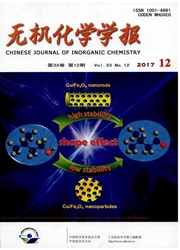

 中文摘要:
中文摘要:
通过变温单晶X射线衍射和透射电镜实验对2种金属-有机钙钛矿材料[C(NH2)3][Mn(HCOO)3] (1)和[(CH2)3NH2][Mn(HCOO)3] (2)进行表征,分析了其晶体结构和晶格常数随温度变化的关系,发现2种材料沿c轴方向都表现出负的热膨胀行为,其效应分别为:αc1=-1.2(1)×10^-5 K^-1,αc2=-6.1(11)×10^-5 K^-1。采用一种“铰链”结构模型对这2种框架材料的负热膨胀机理进行了详细解释:温度升高会诱导框架中主体和客体铵基之间的氢键长度及键角发生改变,引起钙钛矿框架结构发生变形,进而导致其沿框架对角线方向(c轴方向)的负热膨胀行为。
 英文摘要:
英文摘要:
Lattice parameters and crystal structures of two metal-organic perovskites[C(NH2)3] [Mn(HCOO)3] (1) and [(CH2)3NH2] [Mn(HCOO)3] (2) are investigated via variable-temperature single-crystal (VT-SCRD) X-ray diffraction and transmission electron microscopy (TEM) experiments. The significant negative thermal expansion (NTE) phenomena along their c-axes are revealed. The average NTE coefficients of frameworks 1 and 2 are αc1=-1.2(1)×10^-5 K^-1 and αc2=-6.1(11)×10^-5 K^-1, respectively, obtained via linear fits using the Pascal software. A hinge-strut like structure model is used to explain the NTE mechanism of these two frameworks, the perovskite frameworks 1 and 2 can be considered as a simple hinge-strut like structure which is a prototypic motif for anisotropic thermal expansion, the formate ligand and Mn(Ⅱ) stand for the hinge and strut, respectively, the hinge angles are represented as θ and φ. The results indicate that the hydrogen bond lengths and angles between the anion framework and the A-site amine cations change slightly with increasing temperature, which induce the distortion of the perovskite frameworks and give rise to the increase of the hinge angle θ but decrease of φ with increasing temperature. These structural rearrangements result in the NTE along the diagonal of the pseudocubic perovskite framework. Furthermore, the two frameworks show significantly different thermal expansion properties due to their distinct modes of hydrogen-bonding between the framework hosts and A-site amine cations. In framework 2, each[(CH2)3NH2]+ is aligned with the ac plane and bonded to the two opposite edges within the same face of the pseudocubic unit cell by four hydrogen bonds. However in framework 1, each[C(NH2)3]+ is cross-linked to two perpendicular edges from two opposite faces of each pseudocubic unit cell by six hydrogen bonds and tilted with respect to the ac plane, which consequently gives more cross-linking constraints to the cubic unit ce
 同期刊论文项目
同期刊论文项目
 同项目期刊论文
同项目期刊论文
 期刊信息
期刊信息
